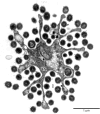Revealing the metabolic capacity of Streblomastix strix and its bacterial symbionts using single-cell metagenomics
- PMID: 31492817
- PMCID: PMC6765251
- DOI: 10.1073/pnas.1910793116
Revealing the metabolic capacity of Streblomastix strix and its bacterial symbionts using single-cell metagenomics
Abstract
Lower termites harbor in their hindgut complex microbial communities that are involved in the digestion of cellulose. Among these are protists, which are usually associated with specific bacterial symbionts found on their surface or inside their cells. While these form the foundations of a classic system in symbiosis research, we still know little about the functional basis for most of these relationships. Here, we describe the complex functional relationship between one protist, the oxymonad Streblomastix strix, and its ectosymbiotic bacterial community using single-cell genomics. We generated partial assemblies of the host S. strix genome and Candidatus Ordinivivax streblomastigis, as well as a complex metagenome assembly of at least 8 other Bacteroidetes bacteria confirmed by ribosomal (r)RNA fluorescence in situ hybridization (FISH) to be associated with S. strix. Our data suggest that S. strix is probably not involved in the cellulose digestion, but the bacterial community on its surface secretes a complex array of glycosyl hydrolases, providing them with the ability to degrade cellulose to monomers and fueling the metabolism of S. strix In addition, some of the bacteria can fix nitrogen and can theoretically provide S. strix with essential amino acids and cofactors, which the protist cannot synthesize. On the contrary, most of the bacterial symbionts lack the essential glycolytic enzyme enolase, which may be overcome by the exchange of intermediates with S. strix This study demonstrates the value of the combined single-cell (meta)genomic and FISH approach for studies of complicated symbiotic systems.
Keywords: Bacteroidetes; Streblomastix; ectosymbionts; oxymonads; termite.
Conflict of interest statement
The authors declare no conflict of interest.
Figures







Similar articles
-
Single-cell amplicon sequencing reveals community structures and transmission trends of protist-associated bacteria in a termite host.PLoS One. 2020 May 15;15(5):e0233065. doi: 10.1371/journal.pone.0233065. eCollection 2020. PLoS One. 2020. PMID: 32413056 Free PMC article.
-
Complex coevolutionary history of symbiotic Bacteroidales bacteria of various protists in the gut of termites.BMC Evol Biol. 2009 Jul 9;9:158. doi: 10.1186/1471-2148-9-158. BMC Evol Biol. 2009. PMID: 19586555 Free PMC article.
-
Symbiotic innovation in the oxymonad Streblomastix strix.J Eukaryot Microbiol. 2004 May-Jun;51(3):291-300. doi: 10.1111/j.1550-7408.2004.tb00569.x. J Eukaryot Microbiol. 2004. PMID: 15218697
-
[Diversity and function of symbiotic microbes in the gut of lower termites].Wei Sheng Wu Xue Bao. 2006 Jun;46(3):496-9. Wei Sheng Wu Xue Bao. 2006. PMID: 16933630 Review. Chinese.
-
Diversity, Roles, and Biotechnological Applications of Symbiotic Microorganisms in the Gut of Termite.Curr Microbiol. 2019 Jun;76(6):755-761. doi: 10.1007/s00284-018-1502-4. Epub 2018 May 12. Curr Microbiol. 2019. PMID: 29754180 Review.
Cited by
-
Unveiling lignocellulolytic potential: a genomic exploration of bacterial lineages within the termite gut.Microbiome. 2024 Oct 15;12(1):201. doi: 10.1186/s40168-024-01917-7. Microbiome. 2024. PMID: 39407345 Free PMC article.
-
Phylogenomics reveals the evolutionary origins of lichenization in chlorophyte algae.Nat Commun. 2024 May 24;15(1):4452. doi: 10.1038/s41467-024-48787-z. Nat Commun. 2024. PMID: 38789482 Free PMC article.
-
Genomics of Preaxostyla Flagellates Illuminates the Path Towards the Loss of Mitochondria.PLoS Genet. 2023 Dec 7;19(12):e1011050. doi: 10.1371/journal.pgen.1011050. eCollection 2023 Dec. PLoS Genet. 2023. PMID: 38060519 Free PMC article.
-
Large-scale invasion of unicellular eukaryotic genomes by integrating DNA viruses.Proc Natl Acad Sci U S A. 2023 Apr 18;120(16):e2300465120. doi: 10.1073/pnas.2300465120. Epub 2023 Apr 10. Proc Natl Acad Sci U S A. 2023. PMID: 37036967 Free PMC article.
-
TIdeS: A Comprehensive Framework for Accurate Open Reading Frame Identification and Classification in Eukaryotic Transcriptomes.Genome Biol Evol. 2024 Dec 4;16(12):evae252. doi: 10.1093/gbe/evae252. Genome Biol Evol. 2024. PMID: 39570867 Free PMC article.
References
-
- Brune A., Symbiotic digestion of lignocellulose in termite guts. Nat. Rev. Microbiol. 12, 168–180 (2014). - PubMed
-
- Brune A., “Methanogens in the digestive tract of termites” in (Endo)Symbiotic Methanogenic Archaea, Hackstein J. H. P., Ed. (Springer Berlin Heidelberg, 2018), pp. 81–101.
-
- Strassert J. F. H., Mikaelyan A., Woyke T., Brune A., Genome analysis of ‘Candidatus Ancillula trichonymphae’, first representative of a deep-branching clade of Bifidobacteriales, strengthens evidence for convergent evolution in flagellate endosymbionts. Environ. Microbiol. Rep. 8, 865–873 (2016). - PubMed
Publication types
MeSH terms
Substances
Associated data
- Actions
- Actions
LinkOut - more resources
Full Text Sources

